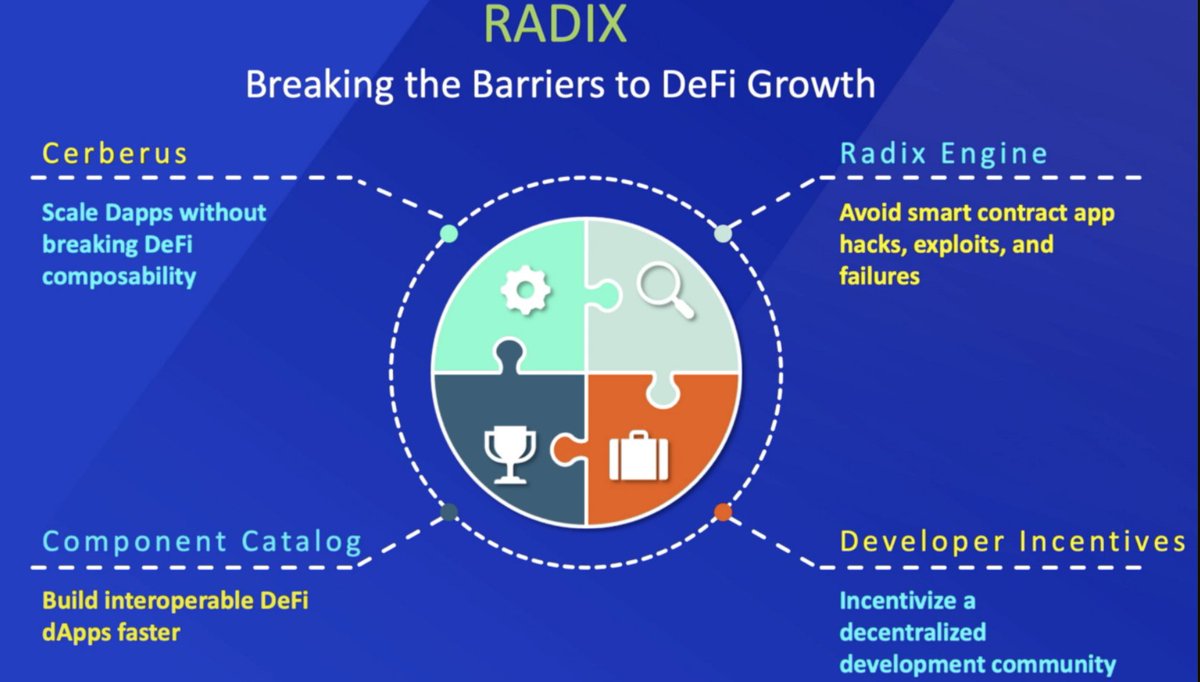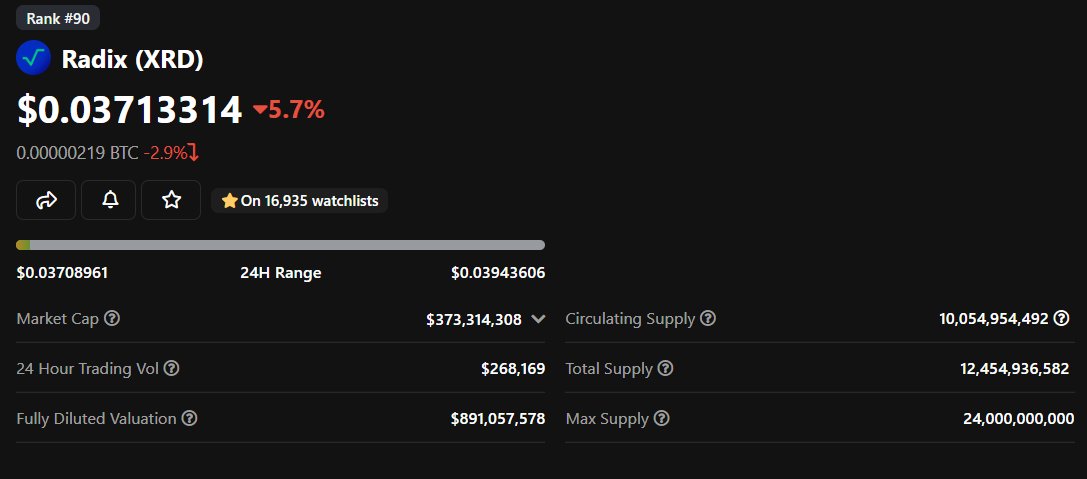
🧵-- $XRD --🧵
🧵 @radixdlt 🧵
🧵#Thread about $XRD and why I think it`s a really great project!
LETS GO!!
@CryptoGirlNova
@cryptocevo
@ociswap
@PostyXBT
@SuperbOwls_xrd
@PiersRidyard
@fuserleer
#Crypto #Cryptoinvestor #100x
$MLT $MTRG $FRM $AZERO
$METIS $FRMx $BNB $BTC
🧵 @radixdlt 🧵
🧵#Thread about $XRD and why I think it`s a really great project!
LETS GO!!
@CryptoGirlNova
@cryptocevo
@ociswap
@PostyXBT
@SuperbOwls_xrd
@PiersRidyard
@fuserleer
#Crypto #Cryptoinvestor #100x
$MLT $MTRG $FRM $AZERO
$METIS $FRMx $BNB $BTC

What is @radixdlt
Radix is basically a layer 1 decentralized protocol that is mainly focusing on #DeFi applications
$XRD also say they are a consensus algorithm that will provide unlimited scalability without breaking #DeFi composability.
a Radically Different DeFi™
Radix is basically a layer 1 decentralized protocol that is mainly focusing on #DeFi applications
$XRD also say they are a consensus algorithm that will provide unlimited scalability without breaking #DeFi composability.
a Radically Different DeFi™

$XRD aims to to make #DeFi safe and scalable beyond limits of current congested slow chains like #ETH, and they have a cool named Consensus called Cerberus!
Cerberus is a unique consensus algorithm designed to underpin the only public decentralized network capable of supporting
Cerberus is a unique consensus algorithm designed to underpin the only public decentralized network capable of supporting

billions of users conducting millions of transactions through unlimited amount of dApps.
Sounds cool!
Lets go!
Sounds cool!
Lets go!

The Cerberus Consensus aims to:
- have cheap affordable transactions
- Unlimited scalability to support as many as it needs ( they use 2256 shards that provide practically unlimited capacity for simultaneous dApps and users)
- ease of use to have a quick adoption
- have cheap affordable transactions
- Unlimited scalability to support as many as it needs ( they use 2256 shards that provide practically unlimited capacity for simultaneous dApps and users)
- ease of use to have a quick adoption

Cerberus also use Atomic cross-shard composability:
It can compose any number of dApps across shards in a single transaction.
Cool stuff and all in one place
It can compose any number of dApps across shards in a single transaction.
Cool stuff and all in one place
They also have a cool feature called Scrypto:
Scrypto is an advanced dApp development language, based on Rust and it is simple to use and easy to any Rust developer out there!
Remember simple = adoption!
Scrypto is an advanced dApp development language, based on Rust and it is simple to use and easy to any Rust developer out there!
Remember simple = adoption!

#Radix also helps developers to deploy modules to be reused by other dApp developers.
$XRD is made from 3 working together systems:
- Radix Engine
- Cerberus
- Delegated Proof of Stake
$XRD is made from 3 working together systems:
- Radix Engine
- Cerberus
- Delegated Proof of Stake

Radix Engine
It`s like EVM Ethereum’s Virtual Machine that represents the layer on which smart contracts are hosted.
The biggest differnt from EVM is that #Radix employs finite-state machines (FSM) to manage the issuance of tokens and also resources
It`s like EVM Ethereum’s Virtual Machine that represents the layer on which smart contracts are hosted.
The biggest differnt from EVM is that #Radix employs finite-state machines (FSM) to manage the issuance of tokens and also resources
Radix Engine if they pull it out as they are going now, will be a big thing in #crypto industry, a really big thing:
Short vid explaining the engine:
Short vid explaining the engine:
https://twitter.com/radixdlt/status/1603700218926665728
Token holders can also participate in transaction validation by delegating to node operators, and that
in return makes node operators share their rewards from transaction validation with them.
That`s why It`s called a delegated PoS system.
in return makes node operators share their rewards from transaction validation with them.
That`s why It`s called a delegated PoS system.
$XRD main usage:
- Staking
- Transaction fees of the blockchain
- Payment system within the network itself
They have recently introduced: The Radix Grants Program to accelerate the blockchain growth and usage. Great forward thinking!
- Staking
- Transaction fees of the blockchain
- Payment system within the network itself
They have recently introduced: The Radix Grants Program to accelerate the blockchain growth and usage. Great forward thinking!

Team:
Piers Ridyard - CEO
@PiersRidyard
Dan Hughes - Founder
@fuserleer
Sophie Donkin - COO
@SophieDonkin
Matthew Hine - CPO
@matthew_hine
Adam Simmons - CSO
@Adam_XRD
Jeremy Epstein - CMO
@jer979
To name a few.
CEO is full of passion! I love that! He is cool!
Piers Ridyard - CEO
@PiersRidyard
Dan Hughes - Founder
@fuserleer
Sophie Donkin - COO
@SophieDonkin
Matthew Hine - CPO
@matthew_hine
Adam Simmons - CSO
@Adam_XRD
Jeremy Epstein - CMO
@jer979
To name a few.
CEO is full of passion! I love that! He is cool!

They also have RadiX Scan, where you can find all the metrics you need...
How cool is that!!!
radixscan.io
How cool is that!!!
radixscan.io
They also have a RadiX Dashboard, another cool feature that everyone should have in the L1`s
I love the commitment they have to the project and transparency!
radixdashboard.com
I love the commitment they have to the project and transparency!
radixdashboard.com
Radix is building an open and interconnected platform with uses such as:
- Stable Coins
- Collateralized Lending
- Perpetual Futures
- Decentralized Exchanges
- Wallets & Dashboards
- Money Markets
- Yield Farming
- #NFTs
- Gaming
- #DeFi Insurance
to nam a few
- Stable Coins
- Collateralized Lending
- Perpetual Futures
- Decentralized Exchanges
- Wallets & Dashboards
- Money Markets
- Yield Farming
- #NFTs
- Gaming
- #DeFi Insurance
to nam a few
Tokenomics:
Price: $0.037
Market Cap $373M
Fully Diluted Valuation: $891M
Circulating Supply: 10,054,954,492
Total Supply: 12,454,936,582
Max Supply: 24,000,000,000
*based on @coingecko
Price: $0.037
Market Cap $373M
Fully Diluted Valuation: $891M
Circulating Supply: 10,054,954,492
Total Supply: 12,454,936,582
Max Supply: 24,000,000,000
*based on @coingecko

I think this is a great project with awesome CEO with compasion and the knoledge to make this blockchain a big one and highly scallable.
If I could I would buy the token itself, but you know I can`t due to financial problems.
DYOR but this is a good one!
If I could I would buy the token itself, but you know I can`t due to financial problems.
DYOR but this is a good one!
Help me go where I want to!
I grind hard to be the thread maker of all times
Improving every week!
ALUCARD OUT
I grind hard to be the thread maker of all times
Improving every week!
ALUCARD OUT

• • •
Missing some Tweet in this thread? You can try to
force a refresh














